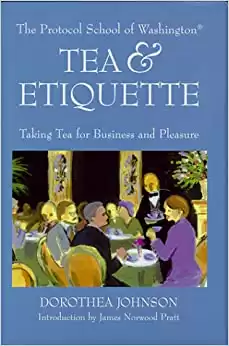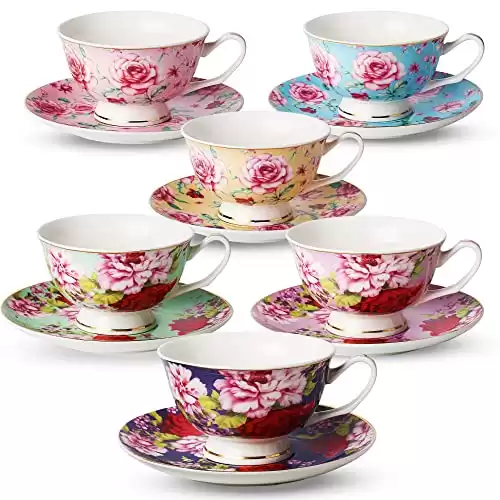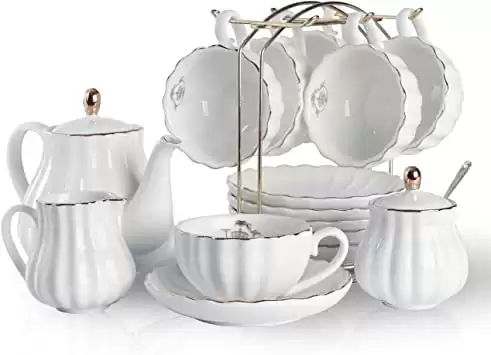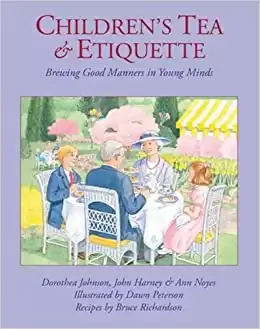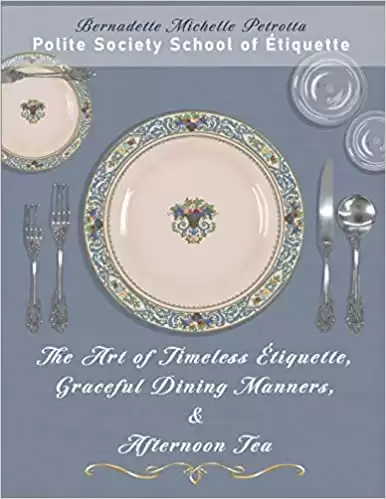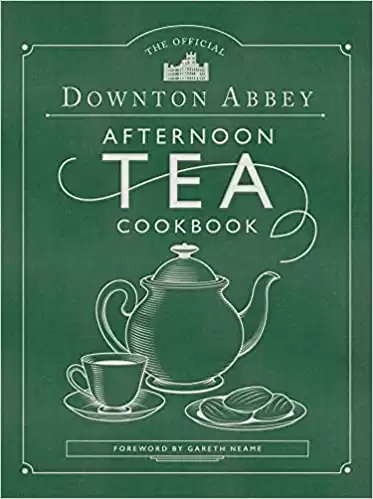Etiquette is “the customary code of polite behavior in society or among members of a particular profession or groups”.
What etiquette is not is a set of morals or ethics. Etiquette is not a cover-all.
Tea etiquette is a learned behavior and something one is not born with. Some of us learned tea etiquette by watching Breakfast at Tiffany’s. Others like me love the royals and the royals love tea.
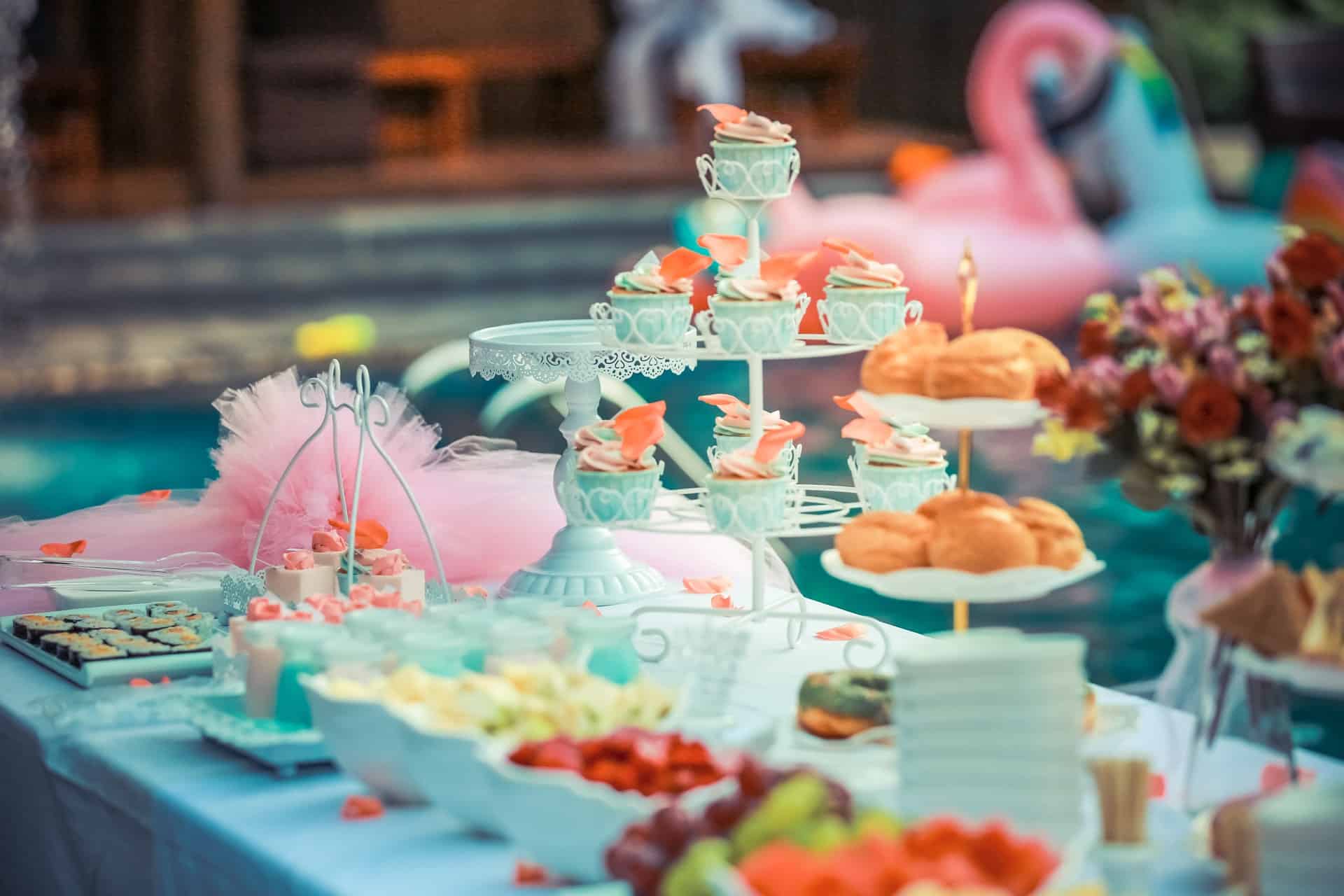
What is etiquette?
Etiquette is the element and behavior of proper conduct. These are created by a certain community or court for certain events. Our community is tea. Our Event is Afternoon Tea. Let’s not confuse afternoon tea with high tea. In fact, even the Queen does not call it High Tea. It’s just TEA! High tea is served around dinner time and usually accompanies a slice of meat or main dish. I’d call that dinner.
Etiquette has nothing to do with your class in life. Etiquette has nothing to do with manners, yet etiquette is manners. Tricky right. Actually, it is not. Tea etiquette is not supposed to be high stress.
There are 5 types of Etiquette
- Workplace – How you act and behave at work. Work has its own etiquette. It’s not a general etiquette but one that is distinct to each workplace.
- Table manners and meals – We learn this in our homes as we are growing up. Once again, our etiquette is distinctive to our culture and upbringing.
- Professionalism – Depending on your job and profession you may have to act in ways that require etiquette. Etiquette that you may not feel but have to perform either way.
- Communication – Always use etiquette when we speak to each other in public. Etiquette is not always fine speech but it is courteous.
- Meeting – The way we greet people whether by opening a door or a handshake or fist bump, is surrounded by etiquette.
Of course, our tea etiquette falls under table manners and meal etiquette. What we will dive into in this article are some of the facts and some of the fiction of tea etiquette.
During the Victorian era, you could not achieve an upper-class status, you were born into it. Some people with an upper-class status have no morals, some people with morals do not have upper-class morals. Today the term upper class is looked at as a person’s economic or financial status.
A few years ago I was at a tea festival where I was able to interview 3rd and 5th generation, Japanese tea farmers. There is a custom when you hand a business card to another person. You use both hands, bow your head as you hand the card to the other person. Etiquette!
Etiquette equals respect.
What is high tea etiquette?
When researching for this article I learned something new. High tea is not what we should say. IF we are wanting to be inside the tea etiquette circle.
There are other words to use that are more exact Those words are:
- Cream tea
- Afternoon tea
- Five O’clock tea
- Light supper
The following is taken from What’s Cooking America
“Most people [i.e. Americans] refer to afternoon tea as high tea because they think it sounds regal and lofty, when in all actuality, high tea, or “meat tea” is dinner. High tea, in Britain, at any rate, tends to be on the heavier side. American hotels and tea rooms, on the other hand, continue to misunderstand and offer tidbits of fancy pastries and cakes on delicate china when they offer a “high tea.”
When high tea was a thing, it was from the 19th century and reserved for those that were rich. For the working class, tea had to wait until after work, or “afternoon tea” or “light supper”. Today, I call it tea or let’s have some tea.
Another note from history is that meals were named by the height of the table it was served on, not the high or low class of society.
So let’s ditch high tea and opt for afternoon tea, or better yet a tea party with friends.
The Pinky
I felt it important to address one of the biggest misconceptions first before entering into the entire tea etiquette.
One of the biggest misconceptions of tea etiquette is the pinkie. It’s shown in movies as the proper way to drink from a cup of tea. Pinkie’s up! We see things in the movies or on the screen and accurate it to be something of statute or etiquette. I mean if the movie stars do it, it’s high class. Because of that people often related the pinky out to mean someone is of elite status. This comes from the fact that people of cultures would eat with three fingers. While those of less status would hold their tea goodies with all five fingers.
In Japan using the pinkie or raising the pinky up is to indicate another man’s wife, girlfriend, or mistress (or possibly all three).
In China, the pinky up is a gesture of insult, not similar to the American middle finger but o a much less level.
So, when you drink tea. Pinkies in, not out, and not up.
Now that being said:
At the beginning of teacups, they were made without handles. Similar to the sake cups of today. To hold a teacup with no handles you place the base of the cup into the small of your less dominant hand. With your dominant hand use your thumb and index finger to hold the cup. The other fingers are used to help maintain control of the cup in your hand while drinking.
The teacup handle was created in the 1700s. You are not supposed to loop your finger into the teacup handle or cradle the cup with both of your hands like a coffee mug.
I remember drinking tea with my grandmother, plunking in sugar cube after sugar cube, and yes, with my pinky finger high in the air. Why? It’s what we saw in the movies. We were sure we were doing it correctly. But, we were not.
So much of tea etiquette was introduced to us through the movies and an assumption that the movies mirrored real life. We were wrong.
Bring Elegance and Beauty to Your Home- Our porcelain tea sets come in British royal style design with exquisite colored glaze. It is pumpkin shaped with glittering gold trim
Tea Party Etiquette
The invitation
The invitations may be given
- In-person
- By telephone
- By mail
- In print
- Handwritten
- Engraved
- Calligraphy
Invitations should be received two weeks prior to the event.
You will need a couple of close friends to pour the teas and be a server at the tea party. This is a complete honor to be asked to do. To pour the teas you are considered a trusted person who knows tea etiquette and has exemplary social skills.
Tea time
What is the perfect time for your party? Traditional tea time is approximately four o’clock but your party can be anytime you wish. The best time for any tea party is between two and five.
Is there a guest of honor?
If you are having a guest of honor make sure that the guests know how they are and why they are the guest. This tea party may be a baby or bridal shower. Make sure you include this information in the invitations so your guests may prepare. The host should greet people as they enter the area or room. The guest of honor should also say goodbye to everyone and thank them for attending.
There was an unwritten rule that no one left until the guest left (unless it was their home). This is still practiced diplomatically but no longer at a typical tea party.
What is proper tea etiquette?
Dress appropriately
While much of the world has learned to dress down parties and events, a tea party is much the opposite. While you don’t have to go all suit and tie at a tea party event, a dress code is considered appropriate.
Some tea parties may even require Victorian Era costumes. But for most afternoon tea parties a dressy casual is perfectly fine. Shy away from jeans and more casual wear. Hair should be kept neat.
Keep personal items off the table
Don’t place phones, glasses, purses, wallets and any other personal items should not be placed on the table. Place these items on the chair next to you.
Napkins
Pick up your napkin and place it unfolded onto your lap. If the napkin is large, fold it with the fold facing your body. If you leave your seat, place the napkin on your seat, not the table. When the tea party is over, pick your napkin up at the center and place it to the left of the plate.
No Smoking
Avoid smoking or using any smoking products that may ruin the taste of the tea and/or pastries. Also, avoid using these products to not offend those around you.
Pinkies down
As discussed earlier. Pinkies should be kept down.
Don’t call it high tea
Unless you are sitting at a table that has some height to it don’t call it high tea. See above.
Don’t lift that saucer
The saucer stays on the table. Lift the cup to drink and replace the teacup with the saucer when finished. While you are sitting at the table there is no need to lift the saucer to drink.
There is a time to lift the saucer. That is when you are a foot or more away and it is appropriate to take the cup along with the saucer with you. The saucer would be held in the left hand (remember cupping the handleless sake cup) and the teacup in your right.
What is the point of a tea saucer?
The saucer is a way of protecting any surface from the heat of the cup or the contact with tea from spilling. The saucer protects both the person, linens, and table that the cup and saucer are sitting on.
Why are saucers called saucers?
The saucer comes from the Latin word salsus. Salsus means sauce. The saucer sits under the teacup to protect the linen, table, and/or holder from heat or spills.
Don’t wrap your hands around the cup
A teacup is not a mug. Refrain from wrapping your hands around the teacup. Hold the teacup in your dominant hand without wrapping your fingers through the handle. Pinch your fingers (forefinger and thumb) through the handle and support with the rest of your fingers and hand at the bottom for support.
Mind where the handle points
Right-handed the teacup handle should face 1500 or 3:00 o’clock
Left-handed the teacup handle should face 2100 or 9:00 o’clock
Don’t look for a teabag
There may not or should not be one. A tea strainer will be in place over the opening of your teacup. The tea will be poured into your cup. Remove the strainer prior to drinking. This removes any tea leaves that may fall from the teapot into your cup.
What comes first
Never put your milk or sugar into your cup prior to the tea. Tea always comes first.
Stirring
When stirring your tea don’t stir in circles. Stir up and down or back and forward. You should consider stirring between 1800 and 0000 or 6 pm and noon. This may take some practice. Making noise or the spoon hitting the sides of the cup is a faux pas. No clanging is acceptable even when removing the teaspoon and tapping it on the cup or saucer.
Don’t leave your teaspoon in the cup
Never leave your teaspoon in your teacup. When not in use, place your teaspoon on the right side of the teacup or behind the teacup.
Don’t put the teaspoon in your mouth
Getting that last drop of tea from the teaspoon is not a given. Tea etiquette says to not put that teaspoon in your mouth. The teaspoons used are for stirring only.
Don’t blow
Allow your tea to cool down on its own. Don’t blow on your tea to cool it down.
Small sips
Ohhh no slurping! Small quiet sips. Quietly enjoying tea is part of tea etiquette. No swishing either. There is no quiet swishing, trust me.
Do not use your tea to help to swallow your food. Tea is to be enjoyed in small sips, not in gulps.
Keeping your teacup and saucer together
When you are asking for more tea, do so with the saucer and teacup together.
Tea equipment for the perfect etiquette of your tea party
The equipment you need will depend on your tea party. If it’s an informal party with just a couple of friends no fancy tea service is needed.
Tea etiquette in china can consist of:
A teapot – Each teacup should be poured individually and not as a mass serving of tea. Prepare your pot by pouring hot water into it first, this heats the teapot and keeps the tea hot longer.
Creamer for milk – use milk and sugar for
Sugar bowl – don’t forget the tongs. I can’t even imagine using my fingers to reach for a sugar cube in today’s world. The word tong means “to bite”. Invented in the 1700s the tongs were used to grab condensed sugar. Sugar cubes are preferred. Easier to handle and less waste.
Pitcher with hot water – This water is used for those that like their tea not as strong as made. This hot water is used to dilute or weaken the tea.
A plate or tray for lemon slices – Most black teas go well with lemon. Lemon is presented as a thin slice. Lemons are placed on a tray and are severed with a utensil that has slight tines to grab the lemons easily. Remember, tea first. Do not put your lemon in the cup prior. Cloves can be added to the lemon and removed prior to serving.
Table setting
If using a tea tray set it and its contents at one end of the table
On the right of the tray place the cups, saucers, and spoons that are needed
Plates, silverware, and napkins go to the left
I like to fold my flatware into my napkins for sanitary reasons and are easy to grasp.
Food items
I love the three-tiered pastry server, it’s simplistic and takes up less tablespace
Do you need flatware?
In certain situations, you will need flatware. Most flatware is used in specific situations and not used to eat with. If there is flatware at each station make sure that you leave it there for the next person. Refrain from using your fingers to pick up items on trays or servers.
When serving a cake that is sticky or too soft to eat with one’s hands a fork can be used
Knives may be used as spreaders for creams, jellies, or butter.
Separate serving spoons should be placed by (or in) each individual container of spread.
Proper placement of flatware goes like this:
- The knife is used as a spreader – the right side of the plate
- Fork – left side of the plate
- Teaspoon – to the right of the knife or on the saucer holding the teacup
Never place used utensils on a cloth or table.
Napkins
Napkins should be made of material or preferably linen over the paper.
Tea etiquette for a three-tier curate stand
Light lunches and sometimes light dinners can be served at a tea party as well. Most tea parties are a very light lunch with finger foods served on a three-tier serving tower that is often shaped something like a pyramid. There is a specific way that the finger foods are arraigned on the tray. Some of the foods you will see are:
- Tea sandwiches
- Nut bread
- Cakes
- Petits fours
- Pastries
- Scones
- Pies
- Cookies
These food items are often placed on a three-tier stand in the following order: You will want to eat these foods in the appropriate order. The order goes savory to sweet. First up are the sandwiches, followed by the scones, and then ending the courses with the sweets.
Top Tier
When the first two services are complete they are removed. What is left is the top tier which includes the sweets! The top tier is actually the last tier to eat. These include:
- Biscuits (cookies)
- Cupcakes
- Tarts
Tiny cakes (petits fours)
Middle tier
The middle or second-tier are for the scones. This tier also includes the jams and jellies to accompany the scones. This is the 2nd course of the evening. You break off bite-size pieces with your fingers to sit on your plate, then add the clotted cream first followed by the jelly or jam. It is now ready to eat. While some establishments may serve scones sliced in half with fillings added, this is a faux pas. While done for ease it is hardly acceptable. A scone should never be sliced and slathered with cream, jam, or jellies.
Bottom tier
The bottom tier is for tea sandwiches. This is the first course at your afternoon tea. Tea sandwiches are small bite-size sandwiches. The sandwiches can be open-faced with thin-sliced bread. Tea sandwiches should not be eaten in one bit but partake of the sandwich in 2-3 bites. Popular sandwiches are:
- Cucumber
- Radish
- Egg salad
- Thinly sliced salmon
These sandwiches can be as simple or elaborate as you wish them to be.
Let’s answer those tea etiquette questions
Is it rude to dunk biscuits?
Simple answer: YES!
Dipping anything into a teacup is just not acceptable. It is frowned upon with great disapproval by those hosting the tea party. But how many people dip? A survey says…71%.
Why do people dip biscuits in tea?
Why do people dip? There is a psychological reason behind the desire to dip. It’s a comfort level and a mouth satisfaction. Dipping brings comfort, and the softening of the scone or item dipped gives it a meltable mouth feel that is very enjoyable to many people.
Who pours the tea?
Proper tea etiquette states that a couple of friends of the host will have the honor to pour tea and serve at the tea party. This is a high honor as the people who are chosen have high social skills as well as exemplary social skills.
Where do I host my tea party at?
For a small party, you can host your party on a patio or backyard with a small table. Tea etiquette states that the party should be in the best room of the house. Generally, that room is a living room or parlor. If serving in a living room or parlor then a tea table and service are not generally needed and the host will do the serving of the tea themselves.
What is the proper way to drink tea?
If at a table always lift the teacup from the saucer. The saucer should remain at the table. The only time to carry both tea and saucer is if you are moving a distance from your table or asking for another cup of tea. Remember… pinkies down!
Why do the English add milk to their teacup first?
When china teacups were first used in the 17th and 18th centuries many were thin and would break under the heat of the tea. Adding the milk first allowed the tea to cool faster and preserve the cups. Some British still do this to this day.
What is tea with milk called?
It is called milk tea. Milk tea refers to any tea that is drunk with milk added to it. Even if it is just a dash of milk in a hot cup. Milk tea can also be referred to as bubble tea, a complex drink with milk, tea, honey, and tapioca pearls.
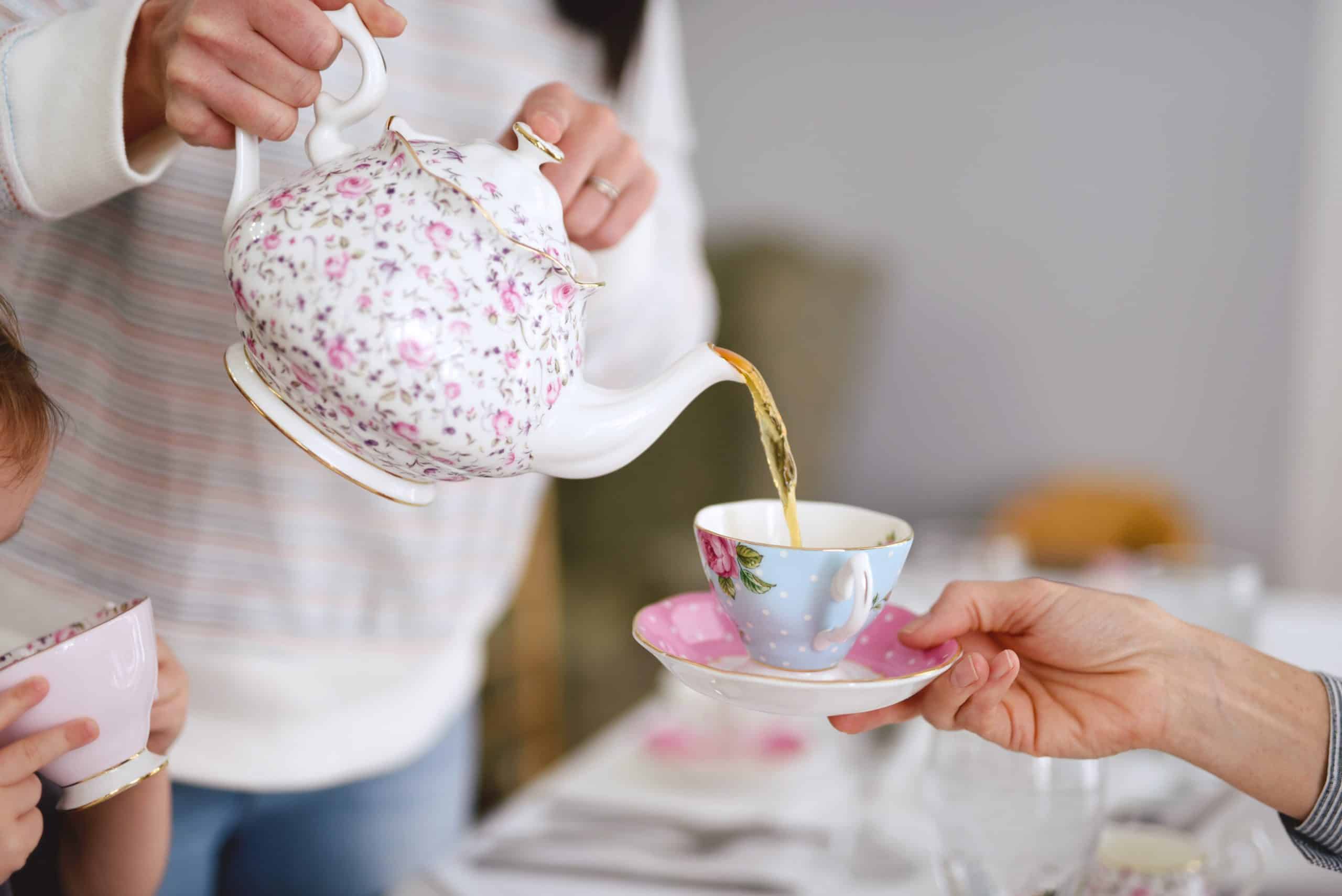
Conclusion
How many times are we invited to a tea party? How do you dress and what is expected of you? Tea etiquette is no different. Being informed prior to the event puts you at ease. You can enjoy the tea party and not worry about what you should or should not be doing. Sit down, relax and enjoy your cup of tea.

